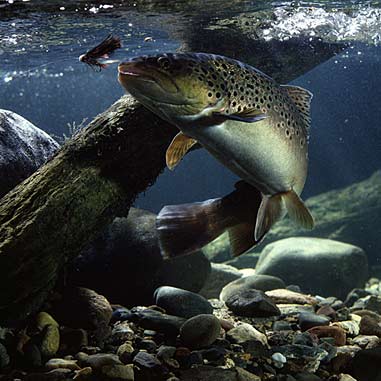To catch the biggest trout this spring, scale down your tackle to ultralight
Ultralight spinning for trout has long been touted as a way of getting more sport from smaller fish by using scaled-down gear. What’s not so evident is that Lilliputian lures, gossamer lines, and midget reels can help you catch not only more trout but larger ones.
Rip Collins of Arkansas provided a great example. His 40-pound 4-ounce all-tackle, world-record brown trout was taken in 1992 from the Little Red River tailwater on ultralight spinning tackle—specifically, 4-pound line and a tiny olive-marabou jig. Although an even larger brown caught last year on heavier gear might displace Collins’s record, this Arkansas giant established the potential of ultralight beyond all argument.
As to numbers of fish, consider this: Most natural food items in a trout stream are small, say 2 inches long and often much smaller. That’s what trout are accustomed to seeing and feeding on, which broadens the fishy appeal of the 1⁄32- to 1⁄8-ounce lures best fished with ultralight gear. That tackle doesn’t fish itself, of course. The right presentation is essential.
Make It Quick
Cast upstream to minimize spooking trout, most of which will likely be facing into the current. The trick here is reeling your lure back downstream just slightly faster than the moving water. That speed provides enough water resistance to keep your lure working properly above the bottom. Trout are used to snatching food items from the current all day long. Your lure in its downstream travel is gaining the most natural presentation possible.
In the fast-moving pocket water common to mountain creeks, you can accomplish this by casting a 1⁄12-ounce Mepps spinner, for example, upstream of a large rock. Reel quickly to keep the lure’s blade spinning while moving your rod tip to steer the spinner along the rock’s edge and through the quieter water below it.
Get the Drift
The second half of the ultralight equation involves drifting tiny lures deep through larger runs and rapids. Cast upstream and across the current while fishing this bigger water. When the lure lands at the end of your cast, don’t reel immediately. Give the lure time to sink as the current pushes it downstream; at the same time, follow its drift with the rod held high to keep the current from tugging on your line and pulling the lure upward.
In deeper runs, cast at a greater upstream angle to gain depth accordingly. In any case, by the time the lure has been carried down to roughly straight across the current from your position, you should be starting a retrieve. That retrieve will depend on the lure. For a spinner, you might twitch the rod tip slightly to start the blade spinning but then not reel at all if the current is strong enough to swing the lure in a deep arc across the flow. Intermittent twitches and pauses will work best with small spoons like Phoebes or Little Cleos, making the lure dart, flash, and then stop briefly like an injured baitfish.
My favorite lure in this scenario is a small marabou jig. (A great many midget jigs designed for crappies make excellent and inexpensive ultralight trout lures.) I let the jig drift and sink until I feel it start to tick the bottom rocks. As the jig starts to swing across the stream, I twitch the rod tip gently to move the drifting jig up and down slightly. I am not reeling at all—just following the drift with my rod tip—because reeling in line during this presentation will move the lure off the bottom and away from the fish.
The real challenge in ultralight spinning for trout lies not just in using hair-thin lines. As with all fishing, refining your tackle means refining your skills to match. What you’ll find is that tiny tackle is not only more sporting than common midsize trout gear, but it’s also more deadly.

